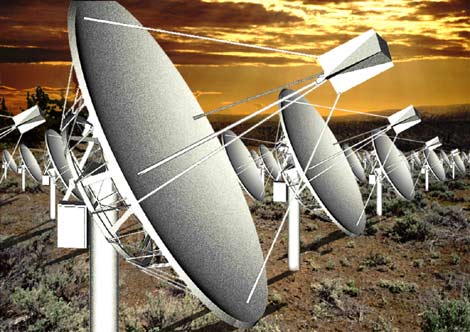|
Finding
life on other planets (Aliens!) is a tantalising prospect that occupies
our daydreams. And yet with the constant onslaught of new technology
are we fast approaching a time when it could become a reality?
By Bruce Dorminey
To humans, the idea of being alone in
a Universe at least 10 to 13 billion light years across is disconcerting.
The philosophical ramifications of being alone in such an overwhelming
expanse of spacetime cannot be overstated. Given everything we know
about the current rate of star and planetary formation, however, it
would seem illogical that we should be the only sentient beings in
the Universe. And given what we do know about the structure of life
here on Earth and of molecules found thus far in the interstellar
medium, it would appear that carbon could be the key to life's development
anywhere in the Universe.
While we can only continue to speculate
about the extraterrestrial development of life and intelligence,
we do know that carbon production is based on the rate of star formation.
Estimates by the Hubble Space Telescope strongly suggest that carbon
production peaked almost 7 billion years ago. Given the time span
necessary for biological evolution as we know it, some theorists
now believe that it is highly unlikely that the Universe could have
seen the first carbon-based intelligent life any sooner than 3 billion
years ago, or when the Universe was already more than 10 billion
years old. In other words, the evolution of extraterrestrial intelligent
life could be a very "recent" cosmic phenomenon. In fact,
as Mario Livio from the Space Telescope Science Institute and Charles
Lineweaver from the University of New South Wales in Sydney have
both pointed out, the Universe may only just be awakening to an
epoch of intelligent life. As Lineweaver has noted, at this stage
in our own development, it is impossible to know whether we have
come late or early to the cosmic party, but in the long history
of our Universe, we might be relative newcomers.

What kind of
transport and communications can we expect ET to have?
|
If there are extraterrestrial civilizations
capable of communicating as we do, shouldn't it follow that the
same basic physics also held for their evolution? Life as we know
it, has its best chance of developing on an Earth-like, fast-rotating
planet in orbit around a Sun-like star, which has a hydrogen-burning
phase that would provide a stable environment for life to evolve.
And even with those parameters in place, ETs would likely emerge
only after their home world had developed some sort of genetic code.
They would also have to become cognizant enough to communicate with
each other. Yet in order to communicate over interstellar distances,
extraterrestrials would first have to overcome the gravity of their
own planet. In order to communicate with us, as Seth Shostak of
the SETI Institute frequently points out, they would have to develop
the dexterity to build technology and telescopes.
If they chose radio, they could easily
overcome the universal cacophony of background noise in the electromagnetic
microwave region (1,000 to 100,000 megahertz). Just above the terrestrial
TV and FM bands, it is relatively quiet. There, only a trace of
background radiation from the Big Bang remains. (This is an effect
anyone can hear in the form of soft constant static when flipping
the dials on an FM radio.) However, the pursuit of ET in the radio
spectrum has a short history. Although decades, even centuries earlier,
there were many ideas about how to signal or find extraterrestrial
civilizations, the genesis of modern SETI really began only some
40 years ago.
In a paper published in Nature in 1959,
the Cornell University physicists Giuseppe Cocconi and Philip Morrison
suggested that the most effective way of communicating across galactic
distances had to be via radio waves. At about the same time, Frank
Drake, a young radio astronomer at the National Radio Astronomy
Observatory in Green Bank, West Virginia, was working on a pet project
named Ozma. (The name came from the mythical Princess Ozma, featured
in L. Frank Baum's fabled Land of Oz: a place far, far away, populated
with strange and exotic beings.)

NRAO and Associated Universities Inc.
The 26 metre
(85 foot) Tatel
Radio Telescope which was built in 1958.
|
Drake became the first radio astronomer
to attempt to detect interstellar radio transmissions from an extraterrestrial
intelligence. On April 8, 1960, he used the novel combination of
sensitive new receivers and a 26-metre radio telescope to survey
several nearby stars, the first of which was Tau Ceti, an early-morning
star in the Cetus constellation some 3.3 parsecs (a parsec being
a distance of approximately 3.26 light years) from Earth. Drake
picked up a strong signal almost as soon as he began scanning with
his single, 100-hertz receiver at the 21-centimetre emission line
(1,420 megahertz), which is the emission frequency of cold hydrogen
from interstellar space. Yet some weeks later, Drake learned that
the "signal" was really terrestrial interference from
a secret U.S. military project.
Despite this frustrating experience
with radio frequency interference (RFI), Drake's efforts prompted
a request from the National Academy of Sciences asking that he organize
a 1961 meeting to discuss the budding Search for Extraterrestrial
Intelligence, or SETI and shortly thereafter the institute was founded.
As University of Arizona astronomer
Neville Woolf points out, looking for evidence of ETI in the radio
spectrum could well be futile, because the ETI may have long moved
on to more advanced forms of communication, which our own technologically
primitive civilization has yet to realize. "Radio SETI is a
noble search", says Woolf. "Yet, if we were to look for
ETI technologies by looking for giant steam engines, people would
laugh because they would say that's old technology. But what's old
on the scale of a Universe that's 10 billion years old?

Ly Ly/SETI
Institute
An Artist's
Conception of the Allen Telescope Array, due to go into full
operation by 2005 in the California Sierra mountains northeast
of San Francisco. With its eventual collection of more than
1,000 antenna, its SETI target list will ultimately number
as many as a million stars.
|
In truth, no matter how dogged our
efforts to find extraterrestrial intelligence, and how advanced
the technologies, SETI astronomers may still miss the mark. "Back-of-the-envelope"
calculations on the median age of possible extraterrestrial civilizations
suggest their technologies would be several million years ahead
of ours. Thus, trying to detect their communications or signals
in the radio and optical spectrums may indeed be as futile as trying
to log on to the Internet by banging on a "talking" drum.
How can we second-guess an extraterrestrial civilization that could
be millions of years ahead of us, if we cannot accurately envisage
what Earth technology will bring in only several hundred years?
We've moved from basic laptop computers to wireless Dick Tracy-style
communicating watches in 10 years. What will be wrought in 10 million
years? As Stuart Bowyer, a retired Berkeley radio astronomer and
long-time SETI advocate, reminded me, we are simply stuck with the
physics that we understand thus far. Bowyer believes that even if
other civilizations are very advanced, communication in both the
radio and optical spectrums will remain viable, and, therefore,
should remain central to SETI's overall approach. He asserts that
in the next 40 years, or by the time NASA and ESA have produced
high-resolution images of an extra-solar "earth", SETI
astronomers will have had a "fair chance" of finding extraterrestrial
technology.

The Pioneer
F spacecraft, destined to be the first man made object to
escape from the solar system into interstellar space, carries
this pictorial plaque. It is designed to show scientifically
educated inhabitants of some other star system, who might
intercept it millions of years from now, when Pioneer was
launched, from where, and by what kind of beings. (With the
hope that they would not invade Earth!)
|
But even if a signal, or "leakage",
is detected, it would be doubtful that we could decipher it, unless
it was intended as an all-points-directed beacon designed to be
decipherable for any civilization that lay in its beam. Certainly,
signal detection would confirm that we were not alone in the Universe,
but true interstellar communication, even over short distances,
would necessitate a transgenerational attitude of collective long-term
effort. Signals sent and returned over distances as short as 10
parsecs would require a round-trip communication transit of at least
65 years, or basically a human lifetime. Sustaining such interest
in the public at large may prove to be optimistic at best. Imagine
a student in a third-grade class some time in the future: the teacher
announces that SETI astronomers have just detected a signal containing
a message from an intelligent technology-bearing extraterrestrial
civilization on an Earth-like planet circling a nearby star. The
announcement would initially be greeted with emotions ranging from
excitement, consternation, curiosity, and bewilderment. Universities
would likely offer whole new curricula based on how Earth's religions
and philosophies would be affected by the news. The Nobel Committee
would award prizes, and the media would have a field day. But by
the time the message had been deciphered, and the international
community had agreed upon and sent humanity's response, the student
would hear the news of ET's reply as he was "getting the gold
watch" at his retirement party. So, dreams of interstellar
E-mail are slightly optimistic.
While profound certainly, the detection
of an alien intelligence, even within 100 parsecs from Earth, would
not be something that most people would think about on a day-to-day
basis. Life would simply go on.
|
An Abridged extract from 'Distant Wanderers' by Bruce Dorminey
(C) By permission of (Copernicus
Books,$29.95/£22) An imprint of Springer-Verlag
New York, Inc
Available to buy from Amazon.co.uk
and Amazon.com.
Bruce Dorminey was a winner
in the Royal Aeronautical Society's Aerospace 1998 Journalist
of the Year Awards. He writes about astronomy and astrophysics
for numerous publications. This is his first book.
|
 |
|
|
